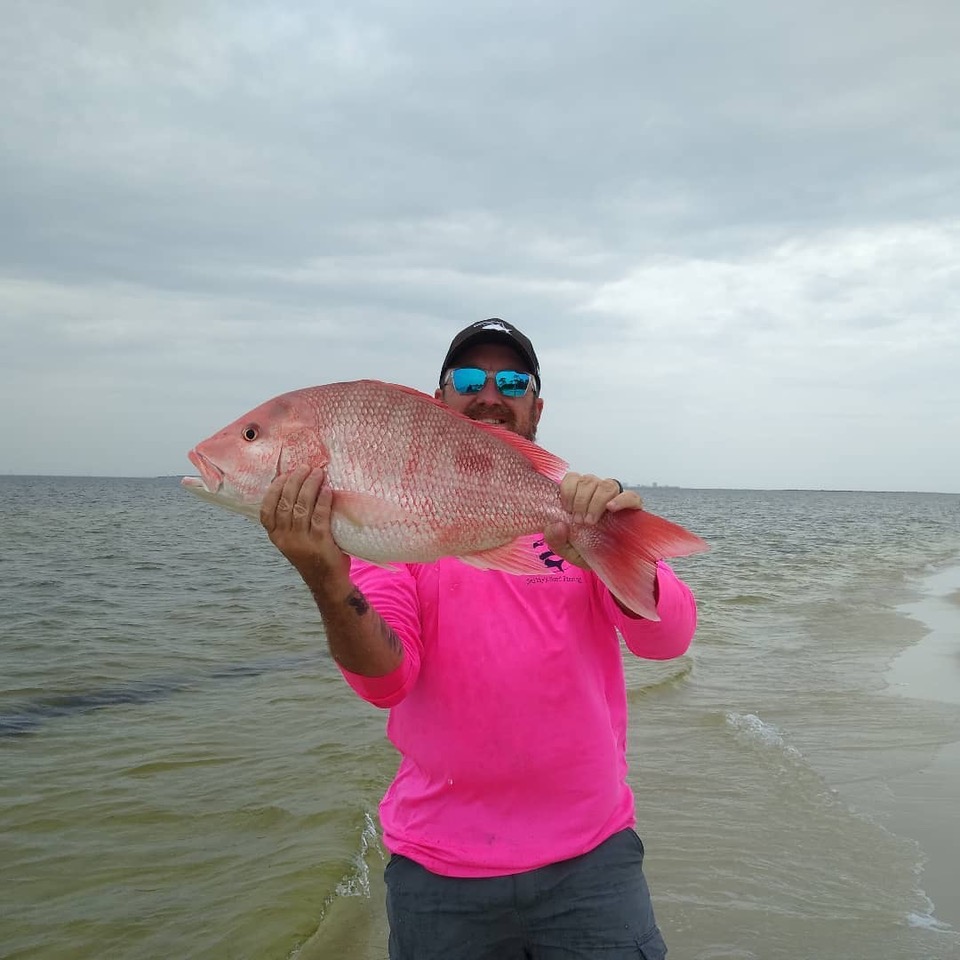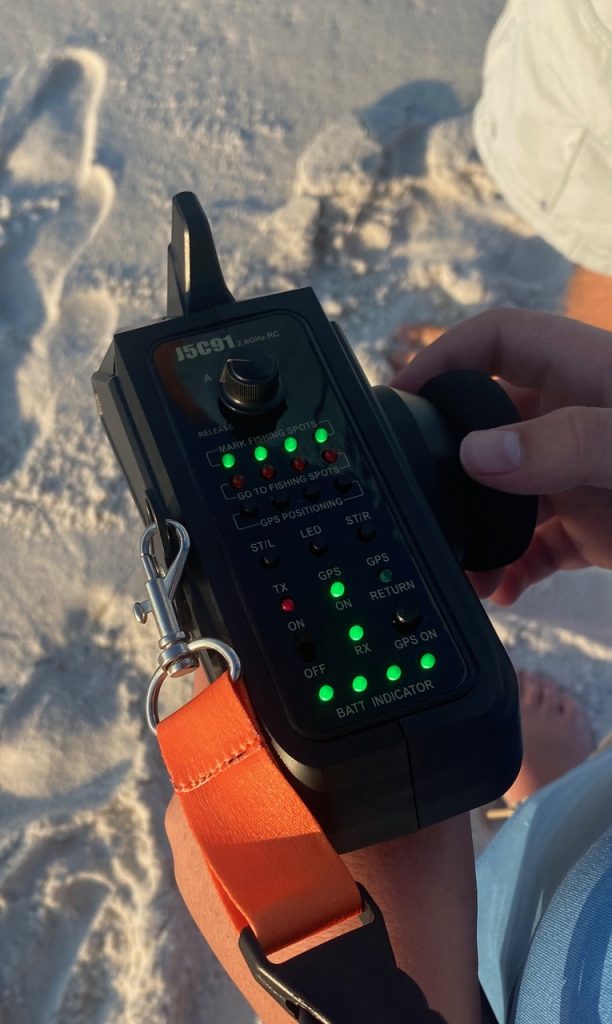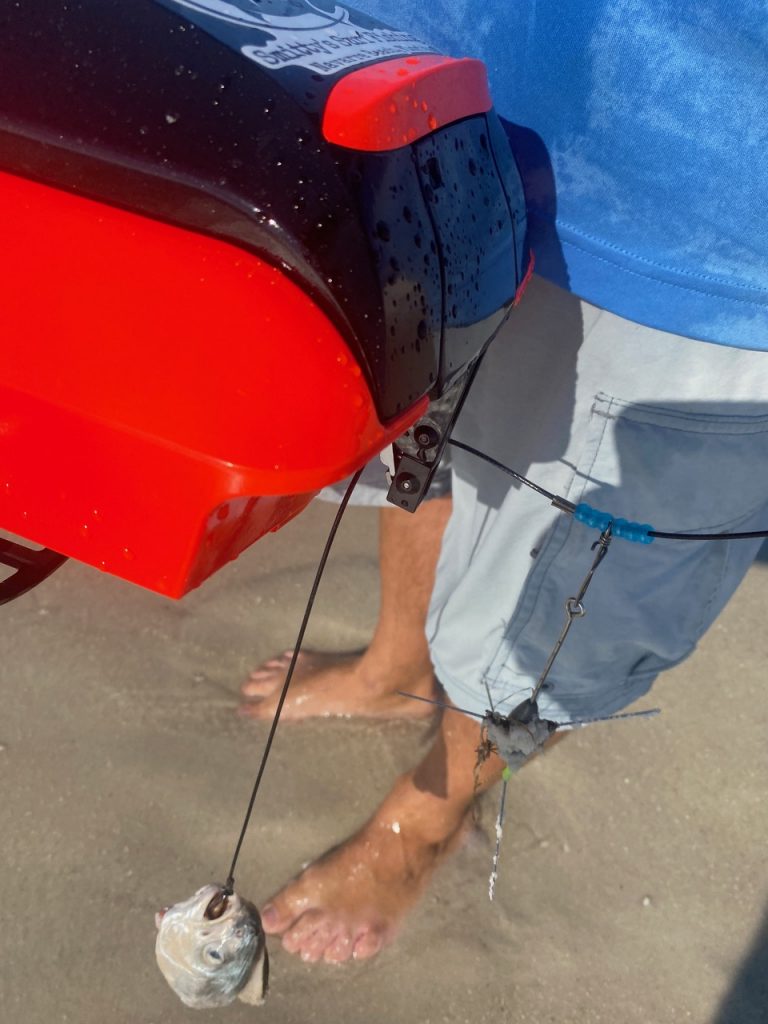Not too long ago, I ordered a remote control (RC) boat to start taking my bait out further than I could cast. Needless to say, when I received said boat, it wasn’t up to the task of taking bait out in the surf. I painfully learned this when fishing with my friend Mike Smith of Smitty’s Surf Fishing, and a no-kidding boat nearly ran over my little RC bait runner. The captain wasn’t at fault (IMO) as he probably didn’t see it when he was running his course, and his wake flipped my poor little boat keel side up and at the mercy of the current. Thankfully, I got it back.
While I was at the drawing board thinking of ways to improve my boat for this task, I hear that a company called Joysway Hobby had just announced a new bait boat at the annual iCast show in Orlando, Florida, Called the RC Fishing Surfer RTR. Naturally, my interest was instantly on level ten, and I had to find this boat. After a quick search, there it was. This skinny-looking red and black boat is waiting to run in the surf. Unfortunately, I saw the price, and I put the thought away for another day and went back to coming up with plans for my “Lucky Floater” (Fitting name after the incident).
That was until Mike called me and said he was getting one of these new boats from RCFishing.World and it would be here within a week. I won’t say I was jealous of my friend’s acquisition of said boat (oh, who are we kidding, I was super excited he was getting it), and I couldn’t wait to see him take it out and fish with it. I, unfortunately, missed the maiden voyage of the Fishing Surfer, and Mike shared the result for the world to see on his YouTube Channel. If you didn’t click the link, I’ll have to spoil it for you now. He caught a coveted Red Snapper (out of season, unfortunately) FROM THE BEACH!

Ok, so I am a snob when it comes to casting and getting distance. I always want to get more distance from my cast. It has become my goal to reach 180 yards, but I average about 150-160 yards roughly with my Okuma Longitude 12′ Rods. Mike drove his boat out about 180 yards with hooks filled with cut Whiting (Southern Kingfish) and dropped them where he saw the contours of the water from his integrated depth finder. Oh, I forgot to mention that? Stay tuned as it is coming shortly. After getting his boat out to the mark, he dropped his bait and set to the boat to return to the launch point via GPS. As expected, it came back to where it launched with no issues. Shortly after that, the rods started going off, and the fishing turned to catching. Without this RC boat, he would have needed a kayak to get out there to that range. Especially with that heavy bait, as there was no walking it out there that far.
So since I teased you a little there, let’s get into the particulars with this tool that is sure to bring your fishing game to a whole new level (you can also click here to read them). The boat is controlled with a 2.4 GHz remote and has an approximate range of 500 meters. The signal is heavily reliant on line of sight, so that the distance could vary in a heavy surf environment. I need to add that this boat is rated for 3-4 ft. waves only by heavy surf environment. Anything higher, you might be playing with fire (don’t test it!) That being said, you can send it out there confidently with a couple of excellent safety features that I’m ecstatic that Joysway put into this boat.
First, if it rolls over in the surf, it has a self-righting feature to get the boat back upright and the propellers in the water. After learning how painful it is to think your investment could be floating out to sea, this is an excellent confidence booster to send it out there. Finally, if your boat loses communication with the controller, it will automatically return to the trip’s starting point. Another exceptionally well-thought-out integration, as loss of communication, is always a possibility with radio wave interference.
The boat is capable of making turns for 15 MPH with its brushless motor set up. I was surprised to see the size of these motors installed (they are tiny) and how much thrust they could produce through the propellers. There are two props on this RC craft, and an outer cage protects them. Now, these won’t save you from grass in the water but will help prevent your fishing line from getting caught in them or from the props hitting the ground when coming into a shallow area.


To control the boat, you have a single handheld remote with several buttons for functions, a trigger to control speed, and a wheel to adjust the course as desired. From the remote, you can also set 4 GPS waypoints to go to. This is a neat feature because you can send the bait back to the same places each time if you’re fishing with several rods. The GPS is also handy if you know the fish are biting in one zone and want to get it right there or if you needed to change locations from a dead spot.

What about the bait, you ask? I’m so glad you did! There are two pins to hold your fishing line for taking out. There is one directly behind the propellers and one in the center of the keel. You drop the bait from the remote control as well. So you know exactly where you’re dropping it. Though, I do have a bit of a concern with pulling out two baits simultaneously. You would need to keep the one in the center of the keel on a short leash as too long; you would likely intertwine with the stern bait and have a mess on your hands.


You also have a fun option of having a boat with or without a fish finder. Joysway chose to install the Tolson TF300, which runs wirelessly back to a handheld display. The information sent back is more valuable than I had expected and is very accurate. The TF300 will tell you the current depth. Still, it will also mark fish and the depth that they are swimming, give you a current water temperature reading (which is more valuable than one might think), and a voltage readout, so you know how much juice you’ve got left (the pain of your tech running out of battery power is real). One particular note, though, with this model is the range. The specifications state that it has a range of 700 ft (213 meters), which is significantly shorter than the range of the RC boat. Something to keep in mind if when you have it out there and the information dies on you. I like the information about where the drop-offs are when running your course and where the fish are marked.

Battery life is also a premium when it comes to the RC world. I didn’t realize how much power these things eat up, and it is something to keep in mind. I do recommend picking up a second or third battery if you plan on running this boat heavily. Mike reported getting “about six runs per battery charge, average about 10 minutes each [run].” That’s a decent life span, but if you’re running four rods, that 40 minutes eaten up in just your first set. I would be picking up a second battery just in case.

Ok, so there is plenty of particulars that I didn’t put in here for you to read, and it is all information that is available online. Here is my opinion of this tool: It is an excellent addition to an angler’s arsenal of fishing equipment. This boat will take you out past the distances that you have been trying to reach to find other species of fish quickly. In the Panhandle of Florida, this boat will take you out to the second bar, which is where the Cobia, King Mackerel, sharks, and other larger fish dwell. To get to those spots, you’d need a kayak, bait launcher, or a friend with a boat. Now, you can get to it while sitting safely on the beach, prepping the rest of your gear for the day.
Great job, Joysway, for creating this boat, and thank you to RCFishing World for being the place to get it quickly here in the USA. If you’re interested in picking up one of these fishing boats, reach out to Dragon Sailing through their website or by emailing info@rcfishing.world . We might also be holding onto a discount code since you read this far. Reach out to us, and we will provide it if it is still available.
ABOUT THE AUTHOR
Brian Demo is an avid surf fisherman in the Florida panhandle. He has studied and fished with some of the most successful anglers in the field of saltwater fishing. Brian is a Veteran of the United States Marines where he served as an H-1 Helicopter Mechanic and Shooting Instructor. After he retired, he traveled the country full-time in his RV with his family in tow seeing some of the best places in America while homeschooling their daughter along the way. He currently lives in Navarre, FL where he works as a mobile RV technician. In his off time, he spends many hours salt water fishing, writing articles about fishing equipment & RV travel, and spending time with his family outdoors.







